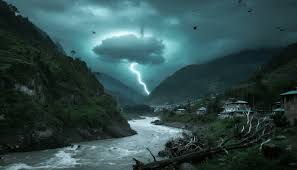Introduction
Cloudbursts in mountainous regions, Cloudbursts in mountainous regions are sudden and intense rainfall events that often lead to devastating natural disasters. These events occur when highly saturated clouds release enormous amounts of water in a very short time, typically over a confined area. In such areas, the steep slopes and rugged terrain amplify the effects, turning heavy rainfall into destructive torrents. Moreover, cloudbursts have become more frequent in recent years due to changing climatic patterns.
These disasters are significant because they not only cause damage to property but also threaten human lives, disrupt local economies, and alter ecosystems. Since they occur without much warning, communities in mountainous zones face heightened vulnerability. The severity of cloudbursts highlights the importance of understanding their causes and impacts. Furthermore, since mountainous regions across the world such as the Himalayas, the Rockies, and the Andes are prone to such incidents, the problem has global relevance. Thus, it becomes necessary to explore both the reasons behind cloudbursts and their multifaceted consequences.
Meteorological Reasons for Cloudbursts
Cloudbursts are primarily meteorological phenomena driven by specific atmospheric conditions. They usually happen when warm air currents rapidly rise and collide with cooler air masses over mountainous regions. As the warm air ascends, it carries moisture that condenses quickly due to sudden cooling. This leads to the formation of dense cumulonimbus clouds, which hold massive amounts of water. When these clouds become unstable, they release precipitation abruptly.
Additionally, the orographic effect of mountains forces moist winds to rise, which further enhances rainfall intensity. Temperature inversions and atmospheric instability also contribute to this process. In many cases, cloudbursts are associated with monsoon systems in Asia or summer convection storms in other parts of the world. Moreover, satellite studies indicate that cloudbursts often form in areas where wind patterns converge, creating localized zones of high rainfall. Consequently, the suddenness of these meteorological shifts makes forecasting cloudbursts difficult. Therefore, understanding these atmospheric dynamics is crucial for disaster management and preparedness strategies in mountainous regions.

Climatic and Environmental Factors
Climatic and environmental factors also play a critical role in triggering cloudbursts. Climate change has led to increased variability in rainfall patterns, causing more intense and erratic downpours in high-altitude regions. Rising global temperatures increase evaporation, which results in greater moisture availability in the atmosphere. This excess moisture intensifies rainfall events when conditions align. Additionally, deforestation and environmental degradation in mountainous areas reduce the capacity of the land to absorb rainwater. This amplifies the destructive effects of sudden downpours.
Melting glaciers, a consequence of warming, also release additional water into the atmosphere, further fueling intense precipitation. Furthermore, human encroachment and unregulated development disturb the ecological balance of mountains, creating conditions favorable for disasters. Increased urbanization reduces vegetative cover, leaving slopes vulnerable. Consequently, natural protective mechanisms against excessive rainfall become ineffective. Thus, the interplay of global climatic changes with local environmental degradation significantly enhances the likelihood and severity of cloudbursts. Therefore, mitigation requires not only meteorological monitoring but also sustainable environmental practices.
Geographic Vulnerability of Mountainous Areas
Mountainous areas are geographically vulnerable to cloudbursts due to their unique terrain and elevation. Steep slopes accelerate water runoff during intense rainfall, turning streams into destructive flash floods. Valleys and narrow gorges funnel this water, increasing its force and destructive capacity. Furthermore, these areas often lack natural water retention structures, which worsens the problem. High-altitude regions also have limited vegetation due to rocky surfaces, reducing water absorption and soil stability. In addition, many mountainous areas are prone to landslides, which are triggered by excessive rainfall from cloudbursts.
The geographic isolation of these areas makes them even more vulnerable, since emergency responses are delayed. Moreover, settlements in valleys or along riverbanks are at higher risk because these are the pathways of sudden torrents. Hydrological systems in mountains are highly sensitive to rainfall variations, and a single cloudburst can alter entire river systems. Thus, the physical landscape of mountains transforms natural rainfall into highly destructive disasters. Consequently, geography is a key determinant in the impact of cloudbursts.
Impact on Human Settlements
Cloudbursts have severe impacts on human settlements in mountainous regions. Villages located near rivers or on steep slopes face immediate devastation when torrents of water rush through. Houses, schools, and infrastructure are often swept away within minutes. Roads and bridges collapse, isolating communities and disrupting communication. Furthermore, water supply systems and electricity networks are damaged, leaving survivors in difficult conditions. Human lives are lost during such disasters, and survivors often face displacement. In developing regions, where construction practices are weak, vulnerability is even higher.
The suddenness of cloudbursts allows little time for evacuation, making them deadly. In addition, the psychological trauma for affected families is immense, as they lose loved ones, homes, and livelihoods simultaneously. Moreover, rescue and relief operations are complicated by inaccessible terrain. Consequently, the social fabric of these communities is disrupted. Thus, cloudbursts pose a direct and long-lasting threat to the safety, stability, and development of human settlements in mountainous environments.
Economic Impact
The economic impact of cloudbursts is profound and long-lasting. Agricultural lands are destroyed by flash floods, wiping out crops and livestock. This creates immediate food shortages and long-term livelihood challenges. Roads, bridges, and transportation networks require expensive reconstruction, straining government budgets. Tourism, which is a key source of income in many mountainous regions, suffers greatly as visitors avoid disaster-prone areas. In addition, small businesses in towns and villages are ruined by the destruction of infrastructure. Insurance claims rise dramatically, although many communities lack formal insurance coverage, leading to uncompensated losses.
Moreover, rebuilding homes and livelihoods drains family resources, pushing many into poverty. The economic shock is not limited to local communities but often extends to regional and national levels. For example, when important highways or hydroelectric projects are damaged, national economies are disrupted. Consequently, cloudbursts create a cycle of economic hardship that hinders development for years. Therefore, economic resilience strategies must be integrated into disaster management plans for mountainous areas.
Environmental and Ecological Impact
Cloudbursts also leave a devastating impact on the environment and local ecosystems. Flash floods triggered by cloudbursts erode fertile soil and wash away vegetation, reducing biodiversity. Landslides caused by heavy rainfall further degrade ecosystems by uprooting trees and destroying habitats. Rivers and lakes become polluted with debris, mud, and chemicals, which harms aquatic life. Furthermore, the sudden influx of water alters the natural flow of rivers, sometimes changing their courses.
Wildlife in mountainous areas suffers from loss of food sources and shelter, leading to long-term ecological imbalances. In addition, cloudbursts contribute to deforestation as trees are uprooted by powerful torrents. Glacial lakes may overflow due to sudden rainfall, creating additional disasters downstream. Moreover, soil erosion reduces the productivity of agricultural land for years. Consequently, these environmental damages disrupt ecological balance and reduce resilience to future disasters. Thus, the environmental impact of cloudbursts extends far beyond the immediate destruction, threatening long-term sustainability in mountainous ecosystems.
Impact on Infrastructure and Development
Infrastructure and development in mountainous regions suffer major setbacks due to cloudbursts. Roads and highways, often built along river valleys or cliffs, are washed away or blocked by landslides. This disrupts transportation and cuts off vital supply chains. Bridges collapse, isolating entire communities for weeks. Furthermore, power plants, particularly hydroelectric projects, face severe damage from sudden floods. Dams and reservoirs overflow, endangering downstream areas. Communication networks are destroyed, making coordination of relief efforts difficult. Schools, hospitals, and government buildings are also affected, delaying social and economic recovery.
Moreover, development projects in progress face delays or cancellations, discouraging investment in the region. The destruction of infrastructure creates a cycle of underdevelopment, as resources are constantly diverted to rebuilding rather than progress. In addition, the cost of reconstruction often exceeds available resources, leaving communities dependent on external aid. Consequently, cloudbursts directly undermine both present infrastructure and future development goals in mountainous regions across the world.

Social and Cultural Impact
Beyond physical damage, cloudbursts also affect the social and cultural life of mountain communities. Traditional practices, festivals, and cultural heritage are disrupted when villages are destroyed. Temples, monasteries, or historical landmarks may be washed away by floods. Families are displaced, breaking community ties that are crucial in mountain societies. Furthermore, survivors face trauma and stress, which weaken social cohesion. Education is interrupted as schools are damaged or used as relief shelters.
In addition, women, children, and the older people face greater hardship in post-disaster scenarios due to lack of resources and support. Migration often increases, as families move to safer areas, leading to depopulation of rural regions. This weakens cultural traditions that are deeply tied to specific landscapes. Moreover, community trust in authorities sometimes erodes when relief is delayed or inadequate. Consequently, the cultural identity of mountain populations is put at risk. Thus, cloudbursts not only damage property but also disrupt the social and cultural continuity of mountain communities.
Global Examples of Cloudburst Incidents
Several regions around the world have witnessed devastating cloudbursts in recent decades. In India, the Himalayan region frequently suffers cloudbursts, with the 2013 Kedarnath disaster being one of the deadliest. Hundreds of villages were destroyed, and thousands of lives were lost due to flash floods and landslides. Similarly, Pakistan’s northern areas have experienced repeated cloudbursts, causing damage to communities and infrastructure. In Europe, parts of the Alps have seen localized cloudburst events that triggered flash floods, affecting tourism and agriculture.
In the United States, the Rocky Mountains experience cloudbursts during summer storms, leading to sudden floods in valleys. South America’s Andes are also vulnerable, where rapid rainfall destabilizes slopes and communities. Moreover, African highlands have suffered such events during intense rainy seasons. These examples highlight that cloudbursts are not confined to a single continent but are a global challenge. Therefore, international cooperation and knowledge sharing are necessary to address the risks effectively.
Mitigation and Preparedness Strategies
Mitigation and preparedness strategies are essential to reduce the impact of cloudbursts. Improved meteorological forecasting can provide early warnings, although predicting exact events remains difficult. Satellite technology and radar systems can track cloud formations and issue alerts. Additionally, building resilient infrastructure, such as reinforced roads and bridges, can reduce damage. Afforestation and soil conservation measures strengthen the natural capacity of mountains to absorb rainwater. Community training and awareness programs prepare people for evacuation and emergency responses. Furthermore, proper land-use planning prevents construction in high-risk zones like riverbanks and unstable slopes.
Climatic impact on sudden rainfall events Governments should invest in disaster management agencies with specialized training for mountainous conditions. Relief centers and stockpiles of emergency supplies must be strategically located. Moreover, international collaboration helps share resources, technology, and expertise. Consequently, proactive strategies can significantly reduce human and economic losses. Thus, while cloudbursts cannot be prevented, their destructive impacts can be minimized through effective preparedness and resilience-building initiatives.
Conclusion
Cloudbursts in mountainous regions represent a complex intersection of meteorological, climatic, geographic, and human factors. They occur suddenly and cause widespread devastation, leaving behind long-lasting impacts on human settlements, economies, environments, infrastructure, and cultural life. Global examples demonstrate that this is not an isolated issue but a widespread problem affecting multiple continents. Although predicting cloudbursts remains a scientific challenge, mitigation and preparedness strategies offer pathways to minimize damage.
Flash floods caused by cloudbursts, Sustainable environmental practices, resilient infrastructure, and community awareness are crucial for adaptation. Furthermore, governments and international organizations must collaborate to enhance early warning systems and disaster response mechanisms. The vulnerability of mountain populations calls for urgent action, as the frequency of extreme weather events increases due to climate change. Ultimately, addressing the reasons and impacts of cloudbursts requires a holistic approach that combines science, policy, and community participation. By doing so, societies can better safeguard mountainous regions and the lives and livelihoods they support.

Your blog is a true hidden gem on the internet. Your thoughtful analysis and in-depth commentary set you apart from the crowd. Keep up the excellent work!
Istanbul Painting and Sculpture Museum tour Istanbul history tour was fascinating. https://skillifier.com/?p=54427
Turkish dessert tour The lunch stop was delicious and well-timed. https://watchxxxfree.club/?p=87601
Chora Church tour The guide’s stories made history come alive. https://vyaani.com/?p=2899
9zkz1q
There’s definately a lot to know about this topic. I love all the points
you made. https://u7bm8.mssg.me/
บทความนี้เกี่ยวกับพวงหรีดดอกไม้ เป็นประโยชน์สุดๆ
การรู้ว่าดอกไม้แต่ละชนิดมีความหมายอย่างไร ช่วยให้เลือกได้ตรงความรู้สึกมากขึ้น
จะเก็บข้อมูลนี้ไว้ใช้แน่นอน
ขอบคุณอีกครั้งครับ/ค่ะ
Here is my web page รับจัดดอกไม้งานศพ